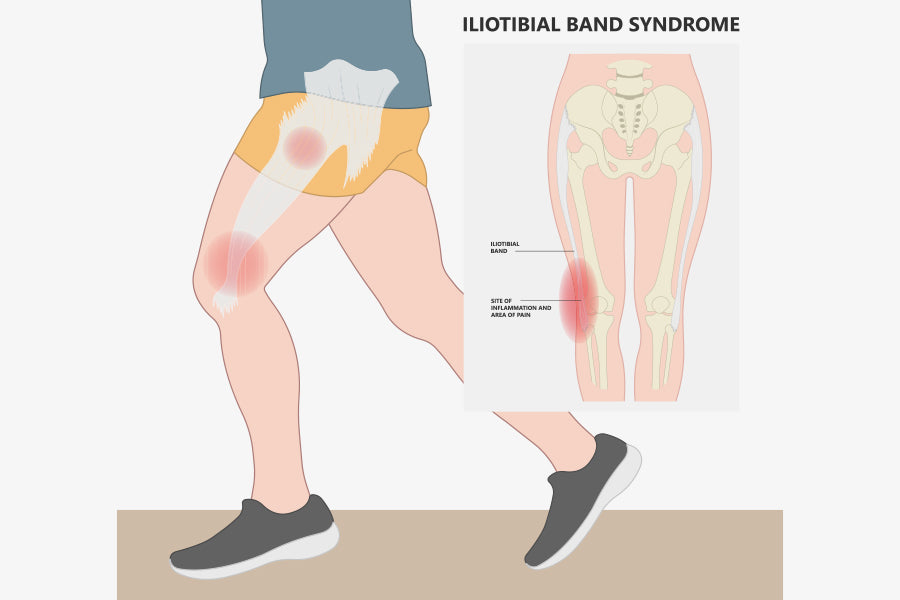If you have ever run a marathon, you know the importance of preparing your body for the challenge. But what if something goes wrong during the race? What if you start feeling pain in your leg that doesn't go away?
You might be suffering from IT Band Syndrome — a common injury among runners. Learn more about this problem and how to treat it in this blog post.
What is the IT Band Syndrome?
This iliotibial tract, or "IT band," as you may know, is a strong and sinuous bodyguard for the knee. It's like a thick rope of protection that stretches from your hip to just below the outside of your shin — with even an attachment point on the side of your kneecap.
The iliotibial band is also a common site of irritation and injury, particularly in runners. When the iliotibial band becomes inflamed, it can cause pain and swell on the outside of the knee.
Iliotibial band syndrome is a condition that occurs when the iliotibial band, a band of tissue that runs from the hip to the knee, rubs against the femur. This can occur when the leg is extended, such as walking or running. The friction can cause inflammation and pain in the iliotibial band, making it difficult to continue activities involving leg extension.
The iliotibial band is essential for stabilizing the knee joint, and when it becomes damaged, it can lead to a loss of mobility and an increased risk of injury.
Related Article: Can Moderate Exercise Reverse Diabetes Damage?
What are the Symptoms of IT Band Syndrome?
Iliotibial band syndrome has some symptoms that make it clear to notice the condition of ITBS.
- Severe pain while running or performing other physical activities that involve knee bending.
- Prolonged pain after exercise, walking or running.
- A knee that is sensitive to a light touch.
- A slight feeling of pain in the buttocks
- Redness and tenderness around the outer side of the knee
- Clicking feeling where the band rubs by the knee.
These symptoms can occur after a short time of physical activity. The pain can prolong if the activity continues and can lead to swelling and extreme pain. The primary symptom of iliotibial band syndrome is severe pain in the lateral part of the hip. This can get severe and increase the injury if the treatment and precautions are not taken immediately.
What Causes IT Band Syndrome?
Here are the causes of iliotibial band syndrome that can help you beware of these slight movements.
Rotatory Motion of Feet
The outward rotation of the foot can stretch the iliotibial band and bring the ITB near your bones. This outward rotation is natural, which can cause this condition.
Hip Abduction
Hip abduction means when your hips turn away from your body. The weakening of this move can cause the iliotibial band to tense and form a sensitive condition.
Twist of Tibial Bone
The tibia is the shin bone that twists inward toward your body. This twist can pull your iliotibial band closer to your bones.
The Problem of Medial Compartment Arthritis
The medial compartment arthritis forms in your knee joint. Genu Varum causes your knee to expand when your feet touch your ankles. This move pulls your iliotibial band and tightens it.
Related Article: Elbow Pain? Ultimate Tips for Training Around Cranky Elbows
What is the Treatment for IT Band Syndrome?
The significant treatment is to stop the physical activities that cause the pain. Reducing or changing physical activity will typically allow the leg to heal fully.
In some cases, ice and over-the-counter anti-inflammatory medication can help reduce pain and swelling. If the pain is severe, your doctor may prescribe stronger medication or provide a corticosteroid injection.
Physical therapy may also be recommended to help stretch and strengthen the muscles around the knee. With proper treatment, most people can fully recover from IT band syndrome.
Make sure you receive ultrasounds or electro therapies to reduce the tension. Surgery is rarely required. Most people with IT band syndrome will experience significant symptom relief with proper treatment.
Most people recover through the iliotibial band syndrome within 4-8 weeks with non-surgical treatments.
Related Article: Exercises to Ease Your Back Pain, Restore Your Health
How Do You Prevent IT Band Syndrome?
There are a few simple things you can do to help prevent it.
First, make sure you're stretching regularly. Stretching the IT band will help keep it loose and less likely to get irritated. Second, cross-train. If you only run, you're putting repetitive stress on the same muscles and joints daily, which can lead to overuse injuries like IT band syndrome.
Mixing up your workouts with swimming, biking, or weightlifting will help give your body a toll from the impact of running.
Finally, be mindful of your form. If you notice that you're starting to run with your hips tilted to one side or your strides are getting shorter and slower, it's time to take a break. The poor form stresses the IT band unnecessarily and can lead to injury.
Following these simple tips can help prevent IT band syndrome and stay pain-free on your runs.
Related Article: Get an Impressive Upper Body With 20-Week Chin Up & Dip Program
FAQs
1. How to relieve the iliotibial band pain at night?
Try using a heating pad or ice pack on the affected area. You can also take over-the-counter pain medication like ibuprofen or acetaminophen. You may want to see a doctor for stronger medication if the pain is severe. Finally, stretches and exercises that target the iliotibial band can help to relieve the pain and prevent future flare-ups.
2. What is the recovery time for iliotibial band syndrome?
Recovery time from iliotibial band syndrome can vary depending on the severity of the condition, but most people fully recover within 6-12 weeks.
3. What is the iliotibial band syndrome in seniors?
Iliotibial band syndrome can occur in seniors since, as we age, we lose muscle mass, our bones may become more brittle, and we may be more susceptible to injuries. It can also be seen in seniors, active runners, or walkers.
4. What is an iliotibial band syndrome test?
The iliotibial band syndrome test is a simple exam that can help diagnose this condition. To perform the test, your doctor will ask you to lie on your side with your affected leg straight. They will gently extend and flex your knee while palpating (feeling) the iliotibial band. You will typically feel pain during this movement if you have iliotibial band syndrome. The iliotibial band syndrome test is a quick and easy way to diagnose this condition.
The Bottom Line
If you’re a runner or cyclist and have been experiencing pain outside your knee, you may have iliotibial band syndrome. This condition is diagnosed with a physical examination and imaging tests, and treatment typically involves stretches and exercises to strengthen the muscles around the knee. Make an appointment with your doctor so they can help you get back to doing what you love without pain.
Reading List
Article Sources
- Shamus, Jennifer, and Eric Shamus. ‘THE MANAGEMENT OF ILIOTIBIAL BAND SYNDROME WITH A MULTIFACETED APPROACH: A DOUBLE CASE REPORT’. International Journal of Sports Physical Therapy, vol. 10, no. 3, June 2015, pp. 378–90. PubMed Central, https://www.ncbi.nlm.nih.gov/pmc/articles/PMC4458926/.
- McKay, Janine, et al. ‘Iliotibial Band Syndrome Rehabilitation in Female Runners: A Pilot Randomized Study’. Journal of Orthopaedic Surgery and Research, vol. 15, no. 1, May 2020, p. 188. BioMed Central, https://doi.org/10.1186/s13018-020-01713-7.
- Lininger, Monica R., and Michael G. Miller. ‘Iliotibial Band Syndrome in the Athletic Population: Strengthening and Rehabilitation Exercises’. Strength & Conditioning Journal, vol. 31, no. 3, June 2009, pp. 43–46. journals.lww.com, https://doi.org/10.1519/SSC.0b013e3181a100a3.











